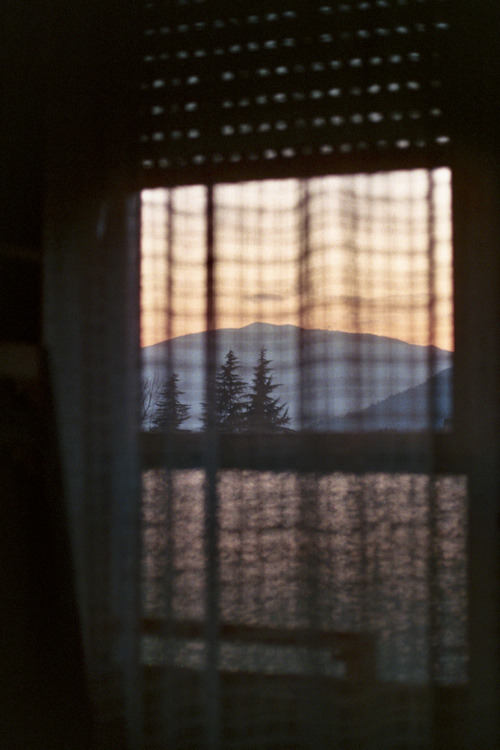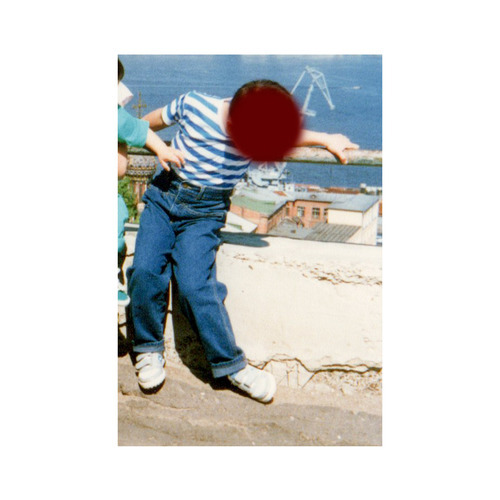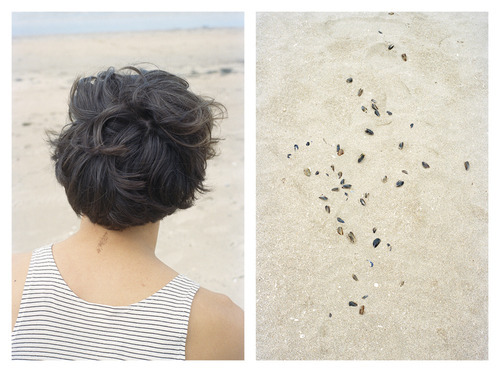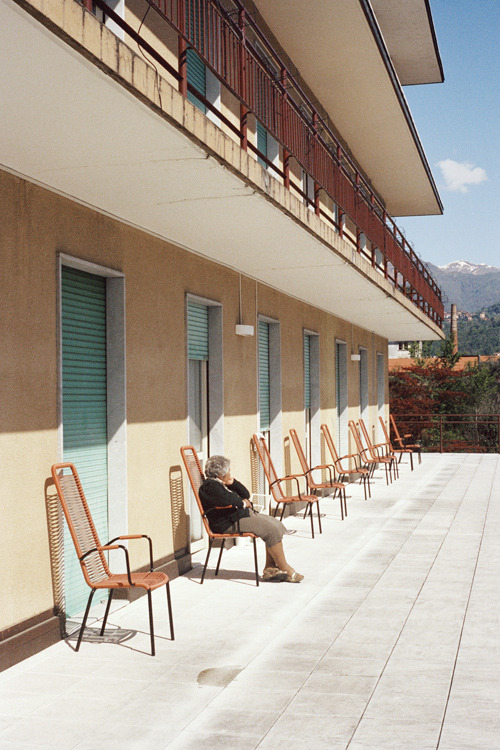The title ‘I see around me tombstones grey’ is a literary quotation. How has the Victorian literature of Emily Brontë influenced the whole project?
Stefano Marchionini (SM): I became interested in the work of Emily Brontë in 2007, after reading Wuthering Heights. During the last year of my studies at the Accademia di Belle Arti in Venice I decided to write a thesis on the film adaptations of the novel, while contextually producing a short film whose fulcrum was a turning point in the book (and film): the famous monologue in which Catherine Earnshaw says “I am Heathcliff.” In the short film, set in the home of my paternal grandmother, the actress, my friend Valentina Mignogna, repeatedly reads some verses of poetry ‘I see around me tombstones grey’: « We would not leave our native home. For any world beyond the Tomb». During the same period I started photographing my family and my hometown, Verbania, and although at that time I did not yet have a clear idea of what it meant to “photograph” (I had just started doing it; until then my artistic practice was limited to drawing and painting), the atmosphere of those first photographs was imbued with those verses. It was natural that the first verse of the poem became the title of a series still in its embryonic stage. Today I still consider it to be the main work of my production, around which many other works were later articulated. The poem that gave the title to the series is still very important to me. Its main themes, namely those of the mother and of Earth—which in poetry are two indivisible entities—and those of the passage of time and our common destiny, are still sources of inspiration in my artistic and personal growth.

© Stefano Marchionini, ‘I see around me tombstones grey’
Even ‘Between the Devil and the Deep Blue Sea’ is accompanied by a written text, 'Savage Others. A Re-collection’, by Margherita Mauro, a writer and playwright living in London. Are the photographic image and the word two complementary elements in your perspective?
SM: The context in which the text of Margherita Mauro is presented within this photographic series is definitely different from that of the series ‘I see around me tombstones grey’: in that series the words have been a source of inspiration in the creative process that went hand in hand with the discovery of the photographic medium and with a succession of family events over time. In ‘Between the Devil and the Deep Blue Sea’, the text is an original creation that came from an open dialogue between an artist and a writer. A text that works as a key to unlock the meaning of a visual imagination. Margherita Mauro worked in complete freedom: the only information I provided was a general explanation of my project and the images that I showed her regularly but without explaining any detail. My hope was that her creation could be freely structured without being affected disproportionately by the stories that can be hidden behind each image. Her text, therefore, acts as a complementary narrative that avoids acting as an explanatory and didactic key. What the reading of 'Savage Others. A Re-collection’ can do is return to the viewer a series of thoughts that the photographic series suggests, filtering them through the intervention of the written word by another author. The ambiguity and doubt generated by the relationship between the text and images is intentional.
'I see around me tombstones gray’ and 'Between the Devil and the Deep Blue Sea’ differ in the photographic form and in the content they communicate. The first is a story linked to memory, to your family, to the place where you were born, to your intimate emotions. The second one talks about the violence, more or less tangible, surrounding the existence of the individual. 'I see around me tombstones gray’ has a narrator; the story of 'Between the Devil and the Deep Blue Sea’ is that of an individual without a face, is that of all of us. How has the filter of digital intervention served you in this? And how much of “you” remains in this work?
SM: The use of digital intervention came from a decision I made in the early stages of my work on this series, when the project seemed to be moving toward its final form. At that moment I decided that the found photographs that would open and close the series had to go through some sort of transformation. I decided not to present them in the form of documentation or proof: my main concern was to avoid a descriptive use by disguising their origin and also by digitally intervening to protect the anonymity of the people portrayed. In ‘Between the Devil and the Deep Blue Sea’ two colors are used as if they were two characters in the story. Their origin is manifold: the red comes from the found photograph that opens the series, to which was later added a dark blue tone. Both colors were later found in the idiomatic expression that gave the title to the series, an expression that I had found, saved on the computer months before, and to which I thought back almost immediately when I created the first images. In a very simple way, the Devil is symbolized by the color red and the blue of the deep sea by dark blue. Their presence in the photographs indicates actions and places that are directly related to the unknown, and unnamed, characters of the story. The biographical material that lies behind these photographs is so blurred, opaque, and hidden. This work, although it possesses all the characteristics of narrative fiction—fiction largely generated by the filter characteristic of photography itself—is definitely a very personal work, especially from a formal point of view. It came at a time when I wondered about the possibility of expressing myself through the medium of photography and using it in a way other than the one to which I had become accustomed in recent years. This series put into question many aspects of my way of taking pictures and then became for me a starting point for further artistic growth.


© Stefano Marchionini, 'Between the Devil and the Deep Blue Sea’
Is there any photographer or some photographic work that particularly stimulated and enriched your visual knowledge?
SM: The first work that blew me away, at the beginning of my photographic practice, was definitely The Devil’s Playground by Nan Goldin. That book is still a rich source of inspiration, although it refers mainly to the memories of my first steps, to a search that was just beginning to take shape in a context mainly related to intimacy and the opportunity to photograph very personal moments. Several moments of my life have been accompanied by the discovery of the works of great artists which have more or less affected me, and that in any case greatly enriched my visual language. I think of my first years in France, in Provence, and the photographs I made in the same places and with the same light that is so characteristic of Willy Ronis. Or when, in Paris, I fell in love with the work of Sophie Calle and Hervé Guibert. Later I became interested in the landscape, thanks to Robert Adams, Bernard Plossu, Jean-Marc Bustamante, Thibaut Cuisset, but also Georgia O'Keeffe. And then the portrait, once again thanks to painters such as Ingres, Titian, Hockney. These and many other artists are to be counted among the landmarks of my training. The greatest source of inspiration was definitely Marguerite Duras: her books were the first that I read in French. They have become personal fetishes and, thanks to the enormous experimentation and research undertaken during her entire life in books, films, and plays, they have also become a direct source of inspiration. One of her most poetic, La jeune fille et l'enfant, taken from the collection L'été 80 and Yann Andréa Steiner, became the starting point for a project I began when I entered the Ecole Nationale Supérieure des Beaux arts in Paris in 2010 and that I presented for the diploma of the third year, two years later. The project, entitled 'La jeune fille et l'enfant’, was originally a notebook of drawings made by listening to a CD containing the text read by Duras herself. Later, the project was open to painting and photography, which I used to create images that would fill the void left by the end of the story between the child and the young animator of the holiday camp. In the photographs I tried to generate the current image of two characters and of what’s left in the place they had lived, on the beaches of Trouville-sur-Mer. Over the years I’ve discovered other photographers and artists, especially young people, thanks to online and personal exchanges. One of the most interesting things is to be able to follow these young photographers through their growth and the evolution of their artistic expression. These meetings have been and still are fundamental—humanly and artistically.

© Stefano Marchionini, 'La jeune fille et l'enfant’
Between the two works, 'Between the Devil and the Deep Blue Sea’ certainly has a more experimental approach, not exclusively tied to photography itself, but to a continuous visual reference with archival images and digital manipulation. A visual search of difficult classification. How has the context of the École nationale supérieure des Beaux-Arts in Paris, where you studied, influenced you?
SM: It would be false to say that the four years I spent at the École nationale supérieure des Beaux-Arts in Paris hasn’t left any traces. It was certainly a vital experience for me. It is equally true that the influence that this school has had on me was not as direct and obvious compared to the works and projects that I made during those years. I tried to make the most of the opportunities I was offered, respecting, however, the creative independence that I always wanted to keep. I never sought the approval of others, instead I took advantage of the freedom that was offered to all students, which for many is a source of a feeling of abandonment by the school. I never felt that way, and I believe that I managed to make my path as honestly as possible. There were exchanges and meetings with teachers and students, but they never directly influenced my work. All research undertaken developed with a pace that I imposed upon myself; I have never been forced to do something to be accepted. However in the last year, that of the final graduation, many issues were raised during the meetings with the students of my atelier and with my main teacher, the artist Patrick Tosani. These dialogues allowed me to significantly increase my knowledge and gave rise to considerations that helped me to see what were the latest changes to be included in my graduate exhibition and also in understanding what roads to take once I finished my educational path.
‘I see around me tombstones grey’ is a self-published project. What do you think of the increasingly rampant world of photographic self-publishing?
SM: I think the recent phenomenon of self-production of photo books is undoubtedly something positive, which is encouraging many artists that in the past would not have thought possible this kind of editorial project. Of course, the more time passes the harder it is to keep up with and be able to follow the publications that are released with an impressive rhythm and abundance. Because of this phenomenon of greedy consumption and reckless production, the downside, in my opinion, is the devaluation of the very concept of the photo book. We publish books too fast and perhaps not enough mature: the enthusiasm can be a double-edged sword when it is accompanied by impatience and lack of preparation. The fear is that in a few years this excitement will give way to mistrust of self-publication.

Still of the book 'I see around me tombstones grey’ by Stefano Marchionini. See here.

© Stefano Marchionini, ‘I see around me tombstones grey’
‘Between the Devil and the Deep Blue Sea’ was shown for your graduate exhibition at the École nationale supérieure des Beaux-Arts in Paris. Are you thinking of publishing it as a book?
SM: My hope is to publish it as a book. The desire is to create an object-book with attention to every detail: from the choice of paper, printing and size, editing and texts. They are all important elements that cannot be left in the background, especially since this series has a limited number of photographs. The final book should respect several criteria so that the photographic work is presented in complete form even outside exhibitions. I studied different possibilities of printing, I have built two prototypes, and I’m getting closer to a version that could be the ideal one. Meanwhile, I have contacted publishers and received a few encouraging notes. I want to dedicate myself to this book for a long time before moving on to something else and I really hope that everything is successful.
From Paris, how do you see the panorama of Italian photography? How do you place yourself in relation to it?
SM: I started to take pictures at the end of 2007, less than a year after I came to live in France. I have to admit that, until recently, I knew very little of the current Italian photography scene. Internet has helped me to grow my interest in photography through the discovery of the work of other photographers. I was not particularly interested in the young Italian photography scene because I did not feel that I belonged to it. It is more appropriate to say I feel like the cousin across the Alps! Lately, however, I have approached Italian photographers thanks to Fabrizio Albertini, whom I know and admire as a friend and as a photographer.
And what about the French photography scene, and specifically Paris?
SM: The French scene is closer to me, for obvious reasons, but I do not feel part of it, as I do not feel part of the Italian one. These territorial limits do not interest me that much. I prefer not to go into these issues. What I can say is that by attending the École nationale supérieure des Beaux-Arts in Paris I approached the very open and varied use of photography by young artists who do not consider themselves photographers. As I am not exclusively interested in photography, these meetings have been helpful to understanding how in the field of photography we should avoid labels, and that the definition of the photographer is now much broader than it was in the past.
What about your future projects?
SM: I’m working on a photographic installation project which I hope to finalize in the coming months. At the moment I am still in the process of conception and design. There are also a couple of video projects I’d like to achieve: a video installation and a short film form that I have just outlined. In short, I have many ideas and I really want to accomplish all these works.
---
LINKS
Stefano Marchionini
Italy
share this page